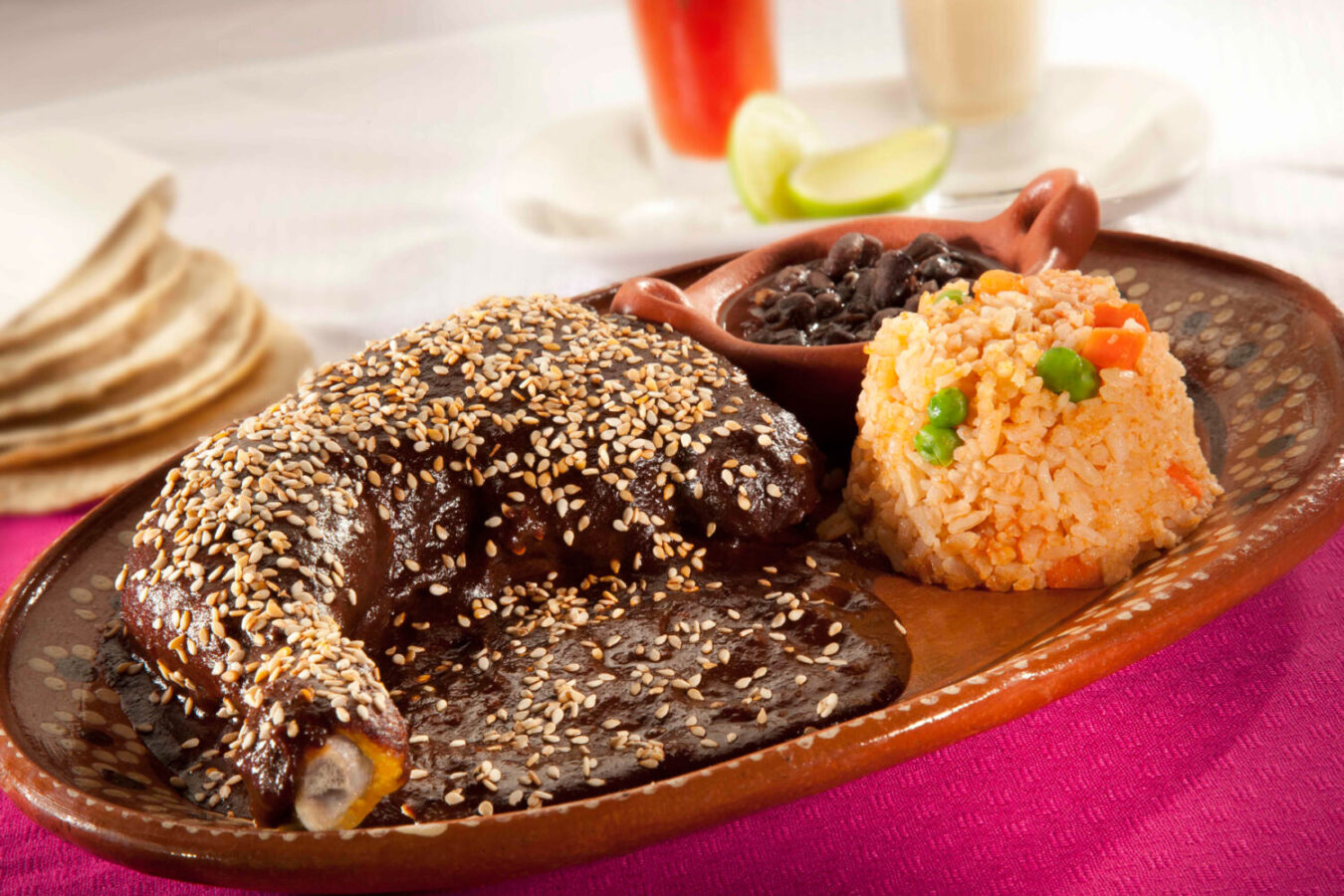WELCOME TO THE MEXICAN SIDE OF LIFE, WE HAVE MOLE
Oh, hi there, Foodies! My name is Abbey. You probably remember me from a little story I wrote before about my Dad teaching me how helpful it is to sip tequila while eating Mole enchiladas.
Remember why? Interested? The full story is over here: https://eatingwithcarmen.com/6-drinks-you-have-to-drink-in-playa-del-carmen
You’ll also find some extra useful curiosities about Mexican spirits and liquors that you don’t want to miss for your next visit to our country.
Tequila, tacos, and mole are the basic gastronomical experiences you should try if you want to turn to the Mexican side.
I know, not everybody really enjoys the intense spiciness of chiles but if you are around the Merida area, you must try chile habanero. Even if it’s just a tiny drop of salsa but promise me you will cross that out from your ¨to do list”
Now, a single shot of Tequila or Mezcal won’t make you blackout and lose your sandals. Well, there is a slight chance that it could, ha! It totally depends on how you decide to sip on it. Although, I don’t think you are going back home without having a shot of Tequila or a Mezcal, am I right?
That’s exactly the way I feel about Mole. For me, eating Mole is a mystical experience, sent straight to our palates from the Aztec gods above. It is such a unique thing, that we would never have thought about in modern society, not even in our best moments of culinary inspiration. Back in Pre-Hispanic times, it was an offering to the gods, sometimes as a token of gratitude after long journeys. Since we Mexicans enjoy turning anything into a big celebration, nowadays, Mole is served on special occasions like weddings, birthdays, or family gatherings.
MOLE, A CULINARY FUSION OF THE OLD WORLD AND OUR CURRENT ONE
Molli, a word that comes from the ancient Aztec language Nahuatl, can be translated as sauce, can be referred to as a combination of mixed sauces or a ground stew.
Over the years, Mole recipes and varieties have evolved, but the great transmitters of Pre-Hispanic recipes were the indigenous cooks who worked in Creole houses and religious convents, bringing dishes with years of tradition to the great kitchens adding ingredients that came from Europe to generate the first mestizo dish.
The varieties of Mole occur according to the geographical location, some ingredients of the recipe might change or may be added, while chiles and spices remain.
There are some states within the Mexican Republic that proudly represent the Mole culture. The state of Puebla, which is located near Mexico City. Veracruz, which is bordering the Gulf of Mexico and at the other end, near the Pacific, is Oaxaca.

OAXACA
This state enjoys a great cultural and gastronomic richness recognized worldwide. Divided into 8 regions, each one is proud to have its own mole. The recipe is adapted to the different ingredients that abound in the area, as well as preparing them differently.
Mole negro: From the region of La Cañada. It has toasted chiles (black chihuacle, red chilhuacle, mulato, pasilla; other recipes include guajillo, chipotle, and ancho), burnt tortilla, yolk bread, plantain, sesame, pumpkin seed, almonds, walnuts, peanuts, onion, tomato, avocado leaf, thyme, clove, pepper, oregano, chocolate, raisins, cinnamon, salt, and sugar. The ingredients should be fried to obtain more intense flavors
Mole Rojo: Made with red chilhuacle, chile ancho (other versions use guajillo, pasilla, cascabel and chile chino), sesame, almonds, chocolate, garlic, onion and epazote. Dried shrimp and pumpkin seeds can be added for a better flavor.
Mole Verde: It represents the Isthmus region. Its ingredients are pumpkin seeds, tomato, green chile, epazote (wormseed), parsley, hierba santa (sacred leaf), onion, garlic, clove, and masa (corn dough made with corn and limestone). This is the only variety in which the ingredients are used fresh.
Mole Amarillo: Preparation made from chile ancho, guajillo, chilcostle and yellow chile costeño (other versions include chilhuacle amarillo), tomato, onion, garlic, cumin, cloves, pepper, tortilla, cilantro, chochoyotes and hierba santa.
Mole Coloradito: From the Valles Centrales (Central Valleys) region. It is a thick mole, but it has a light and sweet flavor. The main ingredients are chile chilcostle, chile guajillo (some recipes use chile ancho and pasilla), yolk bread, chocolate, tomato, garlic, salt, and sugar.
Mancha Manteles (Tablecloth stainer): Sweet and sour, salty and spicy flavors. Ancho chile and pineapple are some of its ingredients. It gets its name from the fact that the stains are impossible to remove from tablecloths… duh.
Chichilo: They use ingredients such as chile pasilla, chile chilhuacle, chile mulato, fat pepper. To give it the characteristic aroma of chili and ashes, avocado leaves are added.
IT’S A MOLE COUNTRY!
Here are some other varieties of mole that have originated in other places, like I previously said, Puebla and Veracruz are also widely known for their moles, but other regions as well have something to offer in the mole-verse:
Mole Blanco or Mole de Novia: One of the newest varieties that originated in the center of the country. It is made with nuts, potatoes, peanuts, almonds, raisins, pulque (a fermented drink from agave), and chile güero.
Mole Almendrado: The most representative is originally from the state of Puebla, it is made from ground almonds and ancho and guajillo chiles.
Mole Rosa: Traditional dish from the region of Santa Prisca in Taxco, Guerrero (Oaxaca’s neighboring state). It is made with cinnamon, almonds, hoja santa, herbs, sesame seeds, chipotle, lard, onion, garlic, mezcal, beet, and pink pine nut.
Pipián: It is a characteristic sauce of the typical cuisine of Puebla, Tlaxcala, Oaxaca and Mexico City, made with pumpkin seeds, depending on the additional ingredients it can have red and green varieties.
Mole de Xico: It has more than 25 ingredients among which are: cashews, dried fruits, three types of chili, and spices. The flavor of this mole, originally from Veracruz, is sweet, sweeter than those mentioned above. A delicacy not to be missed on our Mexican Traditional Food Tour.
Atápakua: This dish is a sauce of Purépecha origin from the central area of Michoacán, which is distinguished for not having sweet notes.
Corn is the key to this mole, as it helps to thicken it. As for the chiles used, they are serrano and guajillo, and sometimes ancho. In addition, mint or cilantro can be added.
This mole can be served with meat, vegetables (mainly mushrooms), and seafood.
Relleno Negro: One of the main dishes of Yucatecan food, made from burnt cha’wa (Yucatecan) chiles. Cooking it underground is a tradition so that the smoke flavor is well impregnated.
In the past, it used to be served with rabbit and wild boar meat, until the time of the Spanish Conquest when it began to be eaten with farm animals like pork and chicken. Nowadays, it is most commonly eaten with turkey.
Mole Madre: Rather than following a single recipe, Mexican Chef Enrique Olvera starts with a Mole base leftover from the day before, dozens of fresh ingredients are added to 2,000 days of uninterrupted cooking sauce fiving the blend lively and slightly different character each day.
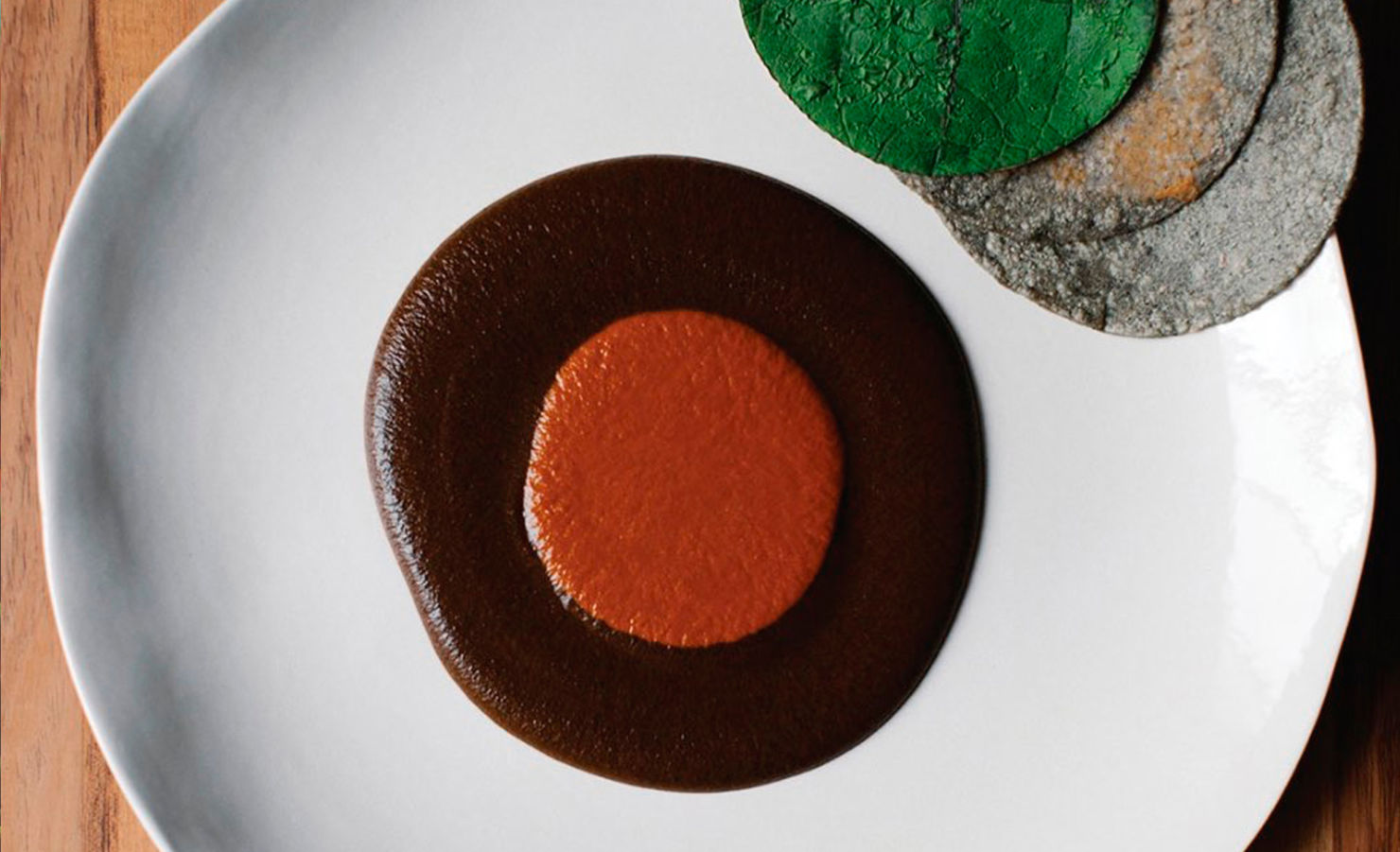
Credit: thehappening.com
Mole Margarita: Inspired by the flavors of traditional Mexican mole, this Margarita from Brooklyn where Tequila is swapped out for an earthy mezcal, which is shaken with lime juice, Cointreau, a black-cocoa-and-orange syrup, and mole bitters before being topped with a splash of soda water. For those who enjoy spicy Margaritas, this drink is a must.
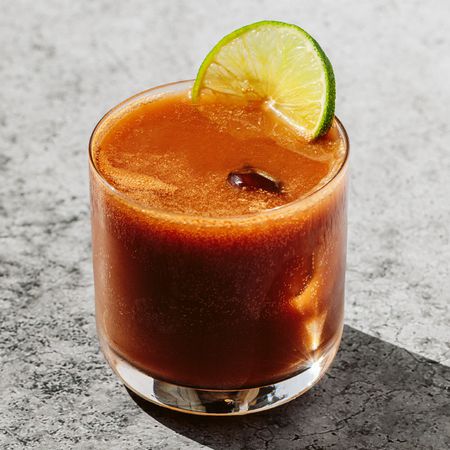
Credit: liquor.com
THE ANATOMY OF MOLE POBLANO, THE MOST FAMOUS MOLE
Puebla is surrounded by 40 pre-Hispanic indigenous settlements and in its conformation, several ecosystems interfere. It is a privileged area in the center of Mexico that allowed the flow of unique culinary materials, giving birth to the first traditional Mexican dishes.
The process of making Mole Poblano or any of the 200 Mole varieties, goes beyond following a simple recipe. Each ingredient is chosen and manipulated intentionally and carefully.
For Mole Poblano we are using the “basic” ingredients:
- Mulato peppers
- Ancho peppers
- Pasilla peppers
- Pepper seeds
- Whole clove
- Black peppercorns
- Coriander seed
- Anises seeds
- Sesame seeds
- Mexican cinnamon sticks
- Raisins Unskinned Almonds
- Peanuts
- Corn tortillas
- Small bread slices
- Raw pumpkin seeds
- White onion
- Medium Roasted tomatoes
- Garlic gloves
- Banana
- Mexican chocolate
- Chicken broth
- Oil or lard
- Salt
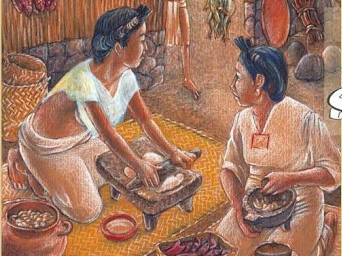
Credit: arqueologiamexicana.mx
Stir-fry ingredients either in a clay pot or on a comal to achieve the characteristic smokey notes in Mole.
Fry the sesame seeds, until you get a darker, more burnt color.
Pasilla, Ancho, and Mulato chiles are left to soak for about 12 hours to soften their texture, then they are dried, cut into small pieces, and fried.
Spices such as anise and cloves, raisins, and cinnamon, sauteed together gradually shape the flavors of Mole.
The banana is caramelized, which adds texture and sweet notes.
Sauteed Almonds, peanuts, and some toasted animal crackers are added.
A few tortillas are taken to the comal, until they are a little burnt.
Fried onion, garlic, and tomato are added to add more flavor, which are added until the end of the process so as not to accelerate their decomposition.
Always salt and pepper.
Chocolate is an essential part of the Mole Poblano recipe. It is an ingredient that in your wildest dreams you would never think of mixing in your main dish, isn’t it? However, chocolate and chile are a delicious and Mexican combination used since ancient times, although not all types of Mole include chocolate.
The now smokey ingredients are taken to get ground up into a smooth paste. In the past, a metate made of non-porous volcanic stone was used as a ground base, which allows it to be properly cleaned to avoid mixing flavors. It is complemented by a grindstone or tejolote which was used to grind the chiles, corn, and spices, however, it has also been identified as being used to extract pigments (minerals or vegetables) in traditional medicine.
Nowadays, a hand mill or a grinder can be used to make it faster and to obtain a better consistency.
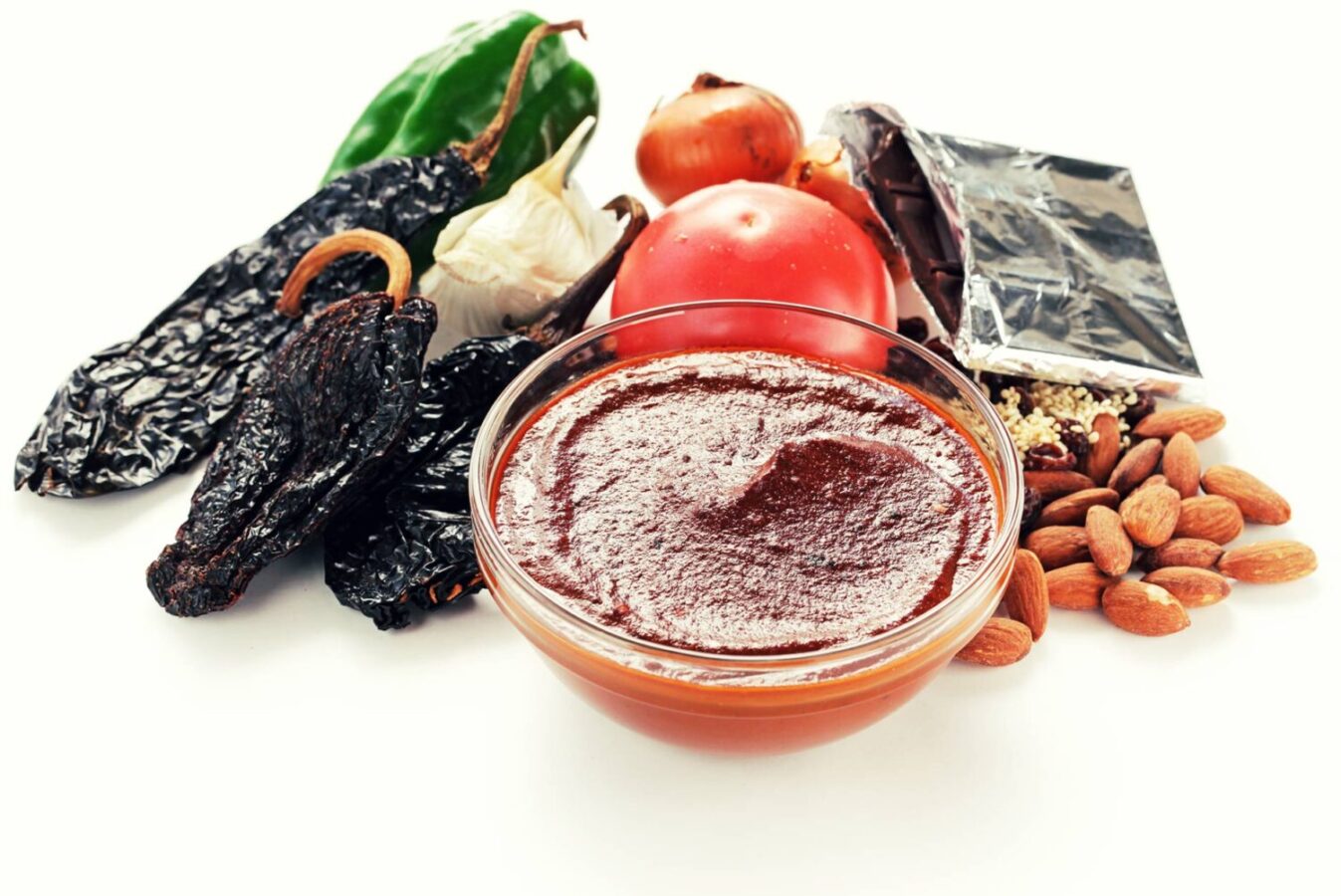
Credit: barcelo.com
Mole paste is added to a large clay pot, filled with chicken and broth, and let simmer for several hours. In many indigenous towns, they traditionally cook with turkey.
The way Mole is served will depend on each region, in the Poblano, the chicken pieces are served, covered with the delicious molli and a little sesame seeds to decorate and highlight the notes of the toasted ingredients.
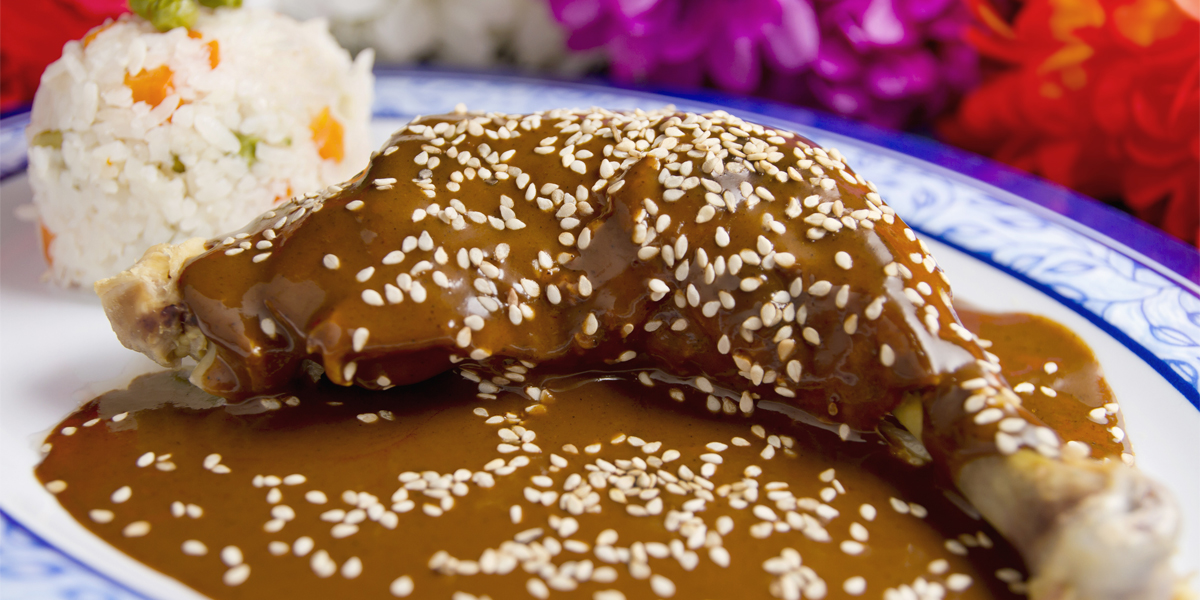
Credit: saboryestilo.com.mx
HOME IS WHERE THE MOLE IS
Cooking traditional dishes symbolizes family union and gives a sense of identity to the Mexican people. Life as we know it has dramatically changed in the last couple of years, bringing many uncertainties, luckily we can count on our taste buds to remind us how food makes us feel. A warm chicken soup, a simple pb&j sandwich or even a single oyster, can take us back to an awakening experience or some old childhood memory, satisfying our hearts and bellies with tradition.
I encourage you to try every Mole that crosses your path and as many Mexican dishes as you can. Chat with the cooks and locals, or join us for a lovely local experience food tour with any of our guides.
-Abbey, a Mole lover.
Mole recipe English https://www.mexicoinmykitchen.com/how-to-make-mole-poblano/
Mole Recipe Spanish https://www.mexicodesconocido.com.mx/receta-mole-poblano.html
Mole Recipe video in Spanish https://www.youtube.com/watch?v=NXGWW8W3mss

